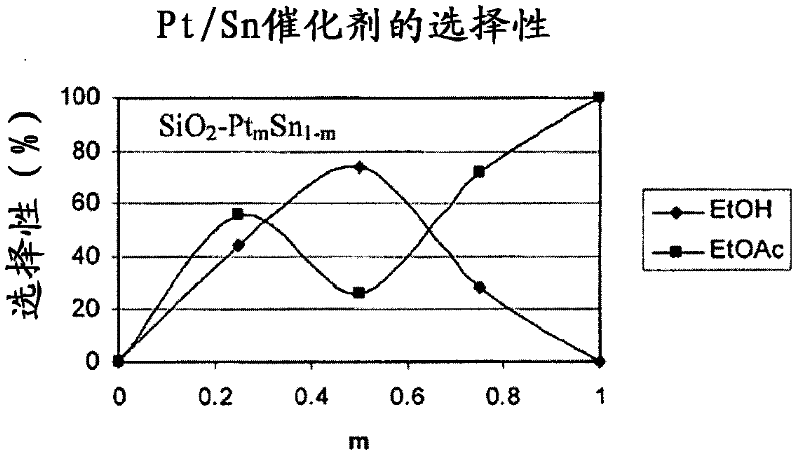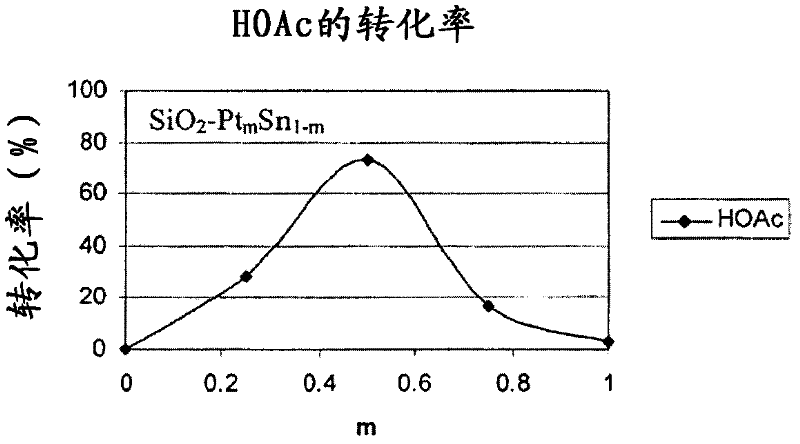Catalyst for the preparation of ethyl acetate from acetic acid
A technology of ethyl acetate and catalyst, applied in the field of catalyst and catalyst preparation, can solve the problems of low conversion rate, highly expensive catalyst, lack of selectivity and the like
- Summary
- Abstract
- Description
- Claims
- Application Information
AI Technical Summary
Problems solved by technology
Method used
Image
Examples
preparation example Construction
[0077] Catalyst preparation method
[0078] The catalyst compositions of the first, second and third embodiments of the present invention are preferably formed by metal impregnation of the support and / or modified support, although other methods such as chemical vapor deposition may also be used. Prior to impregnating the metal, it is generally desirable to form a modified support by the step of impregnating the support material with a support modifier, if necessary. In one aspect, the carrier modifier (such as WO 3 or TiO 2 ) or support modifier precursors are added to the support material. For example, an aqueous suspension of the support modifier can be formed by adding the solid support modifier to deionized water followed by adding a colloidal support material thereto. The resulting mixture can be stirred and added to a further support material using, for example, an incipient wetness impregnation technique in which the support modifier is added to a support material ha...
Embodiment 1
[0123] Example 1 - SiO 2 -CaSiO 3 (5)-Pt(3)-Sn(1.8)
[0124] The catalyst was firstly prepared by CaSiO 3 (Aldrich) added to SiO 2 Catalyst support, followed by adding Pt / Sn for preparation. First, CaSiO 3 (≤200 mesh) aqueous suspension by adding 0.52 g of the solid to 13 ml of deionized water, followed by adding 1.0 ml of colloidal SiO 2 (15wt.% solution, NALCO) for preparation. The suspension was stirred at room temperature for 2 h, and then 10.0 g of SiO was added using the incipient wetness impregnation technique 2 Catalyst support (14 / 30 mesh). After standing for 2 hours, the material was evaporated to dryness, then dried overnight at 120° C. under circulating air and calcined at 500° C. for 6 hours. Then all SiO 2 -CaSiO 3 Material for Pt / Sn metal impregnation.
[0125] The catalyst is obtained by first adding Sn(OAc) 2 (tin acetate, Sn(OAc) from Aldrich 2 ) (0.4104 g, 1.73 mmol) was prepared by adding to a vial containing 6.75 ml of 1:1 diluted glacial acet...
Embodiment 2-KA16
[0126] Example 2-KA160-CaSiO 3 (8)-Pt(3)-Sn(1.8)
[0127] The material is prepared by first adding CaSiO 3 Added to KA160 catalyst carrier (SiO 2 -(0.05)Al 2 o 3 , Sud Chemie, 14 / 30 mesh), followed by the addition of Pt / Sn for preparation. First, CaSiO 3 (≤200 mesh) aqueous suspension by adding 0.42 g of the solid to 3.85 ml of deionized water, followed by adding 0.8 ml of colloidal SiO 2 (15wt.% solution, NALCO) for preparation. The suspension was stirred at room temperature for 2 hours and then 5.0 g of KA160 catalyst support (14 / 30 mesh) were added using the incipient wetness impregnation technique. After standing for 2 hours, the material was evaporated to dryness, then dried overnight at 120° C. under circulating air and calcined at 500° C. for 6 hours. Then all KA160-CaSiO 3 Material for Pt / Sn metal impregnation.
[0128] The catalyst is obtained by first adding Sn(OAc) 2 (tin acetate, Sn(OAc) from Aldrich 2 ) (0.2040 g, 0.86 mmol) was added to a vial contain...
PUM
| Property | Measurement | Unit |
|---|---|---|
| diameter | aaaaa | aaaaa |
| particle size | aaaaa | aaaaa |
| length | aaaaa | aaaaa |
Abstract
Description
Claims
Application Information
 Login to View More
Login to View More - R&D
- Intellectual Property
- Life Sciences
- Materials
- Tech Scout
- Unparalleled Data Quality
- Higher Quality Content
- 60% Fewer Hallucinations
Browse by: Latest US Patents, China's latest patents, Technical Efficacy Thesaurus, Application Domain, Technology Topic, Popular Technical Reports.
© 2025 PatSnap. All rights reserved.Legal|Privacy policy|Modern Slavery Act Transparency Statement|Sitemap|About US| Contact US: help@patsnap.com



